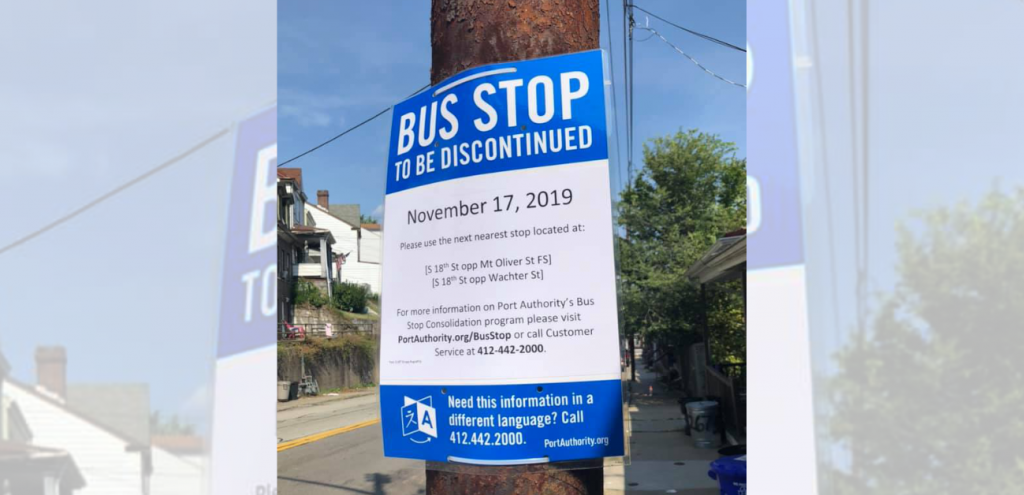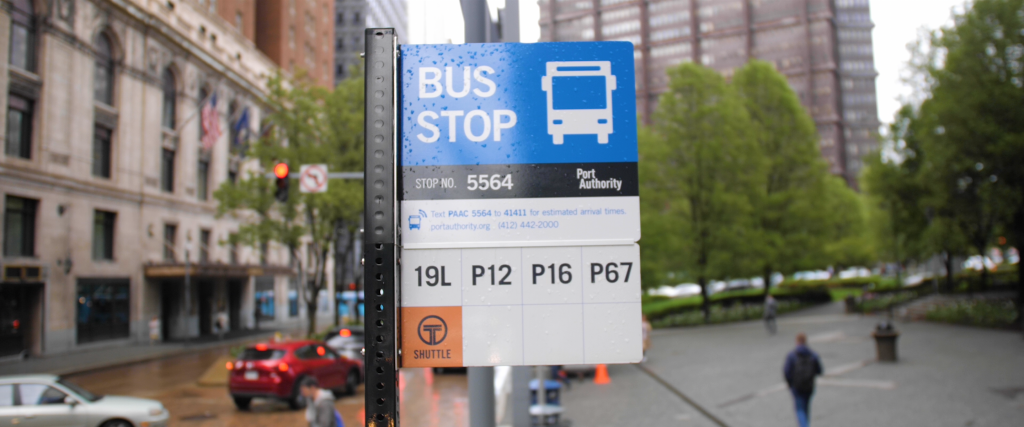
On February 20th, 2020 Port Authority announced that it would slow down on its plan to consolidate bus stops along all 97 of its bus routes. Instead of evaluating new routes for stop consolidation every 3-months, it will move to a 6-month schedule. This is no doubt a win for riders. The slower schedule will allow Port Authority more time to retool their approach to bus stop consolidation, and it will give riders more time to have their voices heard.
Port Authority has taken steps to improve its stop consolidation program since its initial roll-out in September. But this is in no small part due to the organized efforts of hundreds of riders in Carrick, North Side, Garfield, Bloomfield and the rest of the county – publishing opinion pieces, attending meetings, canvassing riders on buses, and submitting feedback.
Port Authority needs to use this momentum to continue improving its process to build a system that supports all of its riders.

Steps forward toward bus stop consolidation that works for all riders:
1. Port Authority needs to define success.
What are the specific goals of bus stop consolidation? A 10% increase to on-time performance? A 5-minute decrease in route run-time? More even stop spacing? Having more bus stops in the system comply with the Port Authority’s bus stop infrastructure guidelines?
Conversely, are there metrics that would have the program be put on hold or even reversed? For instance, what if the data showed a 2% decrease in overall ridership or a 5% reduction in usage by persons with disabilities?
It’s problematic that the Port Authority appears to be using the bus stop consolidation process to eliminate stops that have poor infrastructure rather than seeking to work with municipalities to improve bus stop infrastructure when deficiencies are identified. This should never be the case. Cars are parked illegally at bus stops? Install bollards and paint. Speeding traffic? Lower the speed limit. Dangerous street crossing? Paint high-viz crosswalks. There are low-cost ways to improve pedestrian safety, rather than forcing riders to walk further in unsafe conditions.
2. Show riders actual real-life improvements to their trips
We’ve heard that the Port Authority doesn’t believe that bus riders are willing to give feedback unless their stops are the ones being eliminated. The problem is the Port Authority has not said what exactly the trade-off is. Riders are being asked to limit their entry and exit points into the system, what are they getting in return?
Beyond defining success, Port Authority needs to approach this process from the perspective of a rider. How will improvements to on-time performance translate into meaningful user benefits? It’s worth noting that in Port Authority’s 2018 Rider Survey, riders were most satisfied with Port Authority’s bus service getting them to their destination in a reasonable amount of time (86%), and 80% were satisfied with Port Authority’s on-time performance. Indeed, if riders are using apps & texting to check arrival times, then on-time performance is hardly perceptible, particularly if we’re talking about a minute or two difference. What is instead very noticeable to riders is how much further they have to walk, on widely-varying sidewalk infrastructure and in all types of weather to access their new stops. Can riders expect increased service frequency with any operating savings? Is there a plan for bus shelter installations at the remaining stops?
Eliminating 20-25% of stops should not be considered an end in itself. It cannot be the single published metric for Port Authority staff to determine how many stops are slated for removal on any given route. Instead, Port Authority should be assessing the proximity of specific stops to one another, adjacent amenities, sidewalk/safe crossing infrastructure between stops and to nearby destinations, slope, bus stop usage etc, and then decide how many and which stops to eliminate, if any. Which brings us to our next point:
3. In the selection of bus stops to be removed, Port Authority needs to show their work.
There have been some baffling stops selected for removal during the consolidation process of the 16, 51, 48 and 88, and the average proposed spacing now between stops far exceeds Port Authority’s own bus stop guidelines and is now random and uneven. Port Authority should lay out the specific data points being considered during the bus stop selection process and assign a weight to each point. Port Authority should also clearly state how rider or stakeholder (business/social service agency/housing development) feedback will inform the decision-making in the final selection process. Is there additional consideration given to different bus stop users (older adults, children, riders with disabilities) and uses (such as proximity to a hospital, senior center or grocery store)?
Port Authority should share how many responses they have received about specific bus stops slated for removal. Riders or other stakeholders will be discouraged from weighing in if it’s not apparent that the feedback is being heard and responded to. And Port Authority should consider providing the bus stops elimination list to community organizations along a route prior to posting the individual stops. This would permit these organizations to point out specifics regarding stop use that may have gone unseen by Port Authority staff.
Port Authority also needs to gather and present data on the real impacts of bus stop consolidation on riders, and report it on a regular basis. This data should be measured against the Port Authority goals for the project as well as against their Title VI obligations to ensure that there are not disparate impacts on protected classes (low-income communities, people with disabilities, people of color, older adults, etc).
4. Finally, Port Authority needs to compare apples to apples in its evaluation of bus stop consolidation. Every effort should be made to ensure comparative data is not skewed and that comparisons are fair and legitimate.
We understand that there are several simultaneous efforts being undertaken to improve on-time performance, including modifying bus schedules to more accurately reflect run times and recent efforts to enforce operators leaving the garages at the scheduled time. Moreover, traffic congestion has the single biggest impact on on-time performance, which is widely variable during the winter months due to inclement weather, college school schedules, and holiday travel days. Data that evaluates the change in on-time performance of consolidated routes should also be compared against other routes’ historic and current run times, to have a clear picture of what run-time improvements are attributable solely to the bus stop consolidation effort.